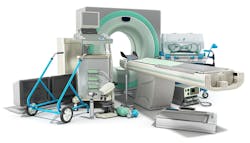Device, equipment maintenance and repair driven by yin–yang yearning
If healthcare organizations wanted to log their utmost desire and deepest fear about the devices and equipment clinicians and administrators use within their facilities, they likely would record dueling acknowledgements: Devices and equipment work continuously as designed when needed without ever going down and that devices and equipment fail to work as designed when needed and go down, respectively.
Aside from the idyllic desires, the reality is that devices and equipment endure normal wear-and-tear from continual use and need to be maintained and repaired as part of the total cost of operation and ownership.
Healthcare organizations, by and large, can choose between three options to care for their devices and equipment, and all three require access to technological knowledge, component parts and labor without negatively affecting any warranty.
- Contracting with the original equipment manufacturer (OEM) via extended warranty program or time-and-materials package
- Contracting with a third-party independent service organization (ISO) in lieu of an OEM
- Working with biomedical/clinical engineering professionals on staff that may be trained and certified.
Each option offers certain benefits and challenges that must be recognized and managed. Not surprisingly, providers and suppliers alike favor specific preferences that generally line up like this: OEMs want to service their own devices and equipment because they stress they have the experience and materials to provide quality service to retain and satisfy customer relationships; ISOs want to compete and generate revenue by offering what they promote as quality maintenance and repair services at lower costs than the OEMs; and healthcare organizations simply want the best of both worlds – that is, OEM reliability and service quality at ISO prices.
OEM vs. ISO
OEM supporters maintain the advantage that the constructors of the equipment know it the most intimately and have the manpower and material resources to keep it working. This can add to the cost of the equipment, which they cover through retail pricing that can be reduced through skillful contract negotiations by group purchasing organizations (GPO) , integrated delivery networks (IDN) or hospital supply chain department leaders. OEM supporters also contend that they must meet federal quality manufacturing and service regulations for their products to be marketed for sale.
Jatin Thakkar, General Manager, Global Services and Solutions, Carestream, echoes Singh by emphasizing equipment experience and knowledge.
These attributes grant OEMs something of an advantage, according to Lynn Salmon, Director of Hardware Sales, Tecsys Inc.
“Similarly, they are likely to have certified service technicians who are equipped with suitable specialized tools and authorized parts and equipment,” she continued. “OEMs also tend to maintain extremely high standards for their own products as it is a direct reflection of their brand. As a result, you can reasonably expect a sophisticated support infrastructure with quick response times. It is also not uncommon to find OEMs that offer favorable warranties as part of their value proposition and as a means to maintain a relationship for future sales. Their incentive to provide cost-effective service through a product’s lifecycle may very well be mutually beneficial. This is compounded by the common practice of offering contract rebates on any outstanding balance to be applied to new devices, providing more flexibility in your upgrade cycle.
“Finally, OEMs often have device-commissioning services, which help organizations configure, test and deploy equipment more efficiently and consistently according to the exacting standards of your selected manufacturer,” Salmon added.
Healthcare Purchasing News reached out to ISO sources for comment, but none responded at press time.
The International Association of Medical Equipment Remarketers and Servicers (IAMERS) is a trade association that represents resellers and servicers of used medical imaging equipment that promotes “the safe and successful roles of independent sellers and servicers,” according to its website. IAMERS refers to the FDA’s 2018 Report on Safety and Effectiveness of Servicing Medical Devices, “the objective evidence indicates that many OEMs and third-party entities provide high quality, safe, and effective servicing of medical devices” and that “the continued availability of third-party entities to service and repair medical devices is critical to the functioning of the U.S. healthcare system.”
IAMERS works to “ensure healthcare providers have choices” and that “independent service providers are committed to ‘best practices’ for patient safety.”
The Repair Association, a group that doesn’t specialize in healthcare, offers a more blunt and sacrosanct philosophy via its web site message: “You bought it, you should own it. Period. You should have the right to use it, modify it, and repair it wherever, whenever, and however you want. We fight for your right to fix.”
Convenience clouds decisions
Company executives who responded to HPN acknowledge that providers may experience hurdles when working with OEMs for maintenance and repair services.
Most notably, “the challenges of OEM service and repair contracts are purported to be higher costs,” Olympus’ Singh indicated. Carestream’s Thakkar points to the possibility that the OEM may not offer coverage in a specific location or area.
Tecsys’ Salmon highlights a variety of preference and workflow issues.
“Not all OEMs prioritize maintenance and repair, favoring instead to sell a new piece of equipment,” she noted. “This is especially true of older or discontinued technology that may have a lot of functional life left in it since supporting multiple generations of tech drags on margin. Because of this, it is possible that OEMs are not well set up to provide maintenance services, leading to longer lead times on replacement parts, which may result in longer repair timelines. It is also possible that out-of-warranty service from OEMs may not be the most cost-effective option.”
Salmon also homes in on customer supply chain operations.
“Another consideration is your device mix and service contract management,” she said. “If most of your equipment and devices are from a small pool of OEMs, juggling a few repair service contracts is simple enough. However, if you have a miscellany of devices from several manufacturers, it may be operationally more complex to work with each OEM over having a third-party service provider that can handle multiple brands and products simultaneously.”
But ISOs can offer benefits under certain caveats, according to Thakkar.
“[ISOs] may be able to support equipment from multiple OEMs and can provide a similar level of support if they are trained and certified by the OEM(s),” he said. “That could present some cost savings if they have the ability to bundle equipment from multiple OEMs.”
However, ISOs present several key challenges, Thakkar added.
“Typically, they don’t have access to all levels of specific training and/or documentation from OEMs,” he observed. “They also don’t work exclusively on OEM equipment so their expertise may be lacking on unique issues. They might still need secondary support from the OEM on complex items and may not be up to speed on the latest features, software and capabilities.”
Singh uses clinical reasoning to justify selecting the OEM over an ISO.
“Healthcare providers must consider the potential costs to patients well-being and the overall health system when medical technologies malfunction because the device was inadequately repaired or serviced by an ISO or the ISO uses materials that have not been proven to work according to specifications and have not been tested for material compatibility with approved methods for cleaning and disinfection,” he said.
Thakkar also recognizes the appeal of healthcare organizations relying on their internal biomedical/clinical engineering professionals for device and equipment maintenance and repair.
“They are internal staff so they’re generally more accessible and their capacity can be flexed based on needs,” he indicated.
But he cautions about their expertise.
“Since they have infrequent contact with equipment, they typically are not the experts on any OEM equipment,” he noted. “They may not be up to date on all current solutions, releases, etc., and may find it difficult to maintain regular training and certifications on all equipment.”
Legislative response
Due to the global COVID-19 pandemic and the resulting supply chain disruptions that hampered access to products, interest in the “right-to-repair” movement and legislation at the federal and state levels continues to percolate. Back in 2021, a New York federal legislator on the House Energy and Commerce Committee introduced H.R. 4006 – Fair Repair Act – for discussion.
Essentially, “right-to-repair” proponents call for ISOs to be granted access to OEM device and equipment service manuals as well as component parts so that end users have more choices for maintenance and repair, which reinforces competition, and therefore leads to lower pricing.
OEMs counter that such information is intellectual property so it should not be provided to any company not authorized, certified and contracted by the OEM to work on proprietary equipment. Further, they contend that price reductions may be offset by longer-term cost increases stemming from any ISO maintenance and repairs that do not meet OEM quality standards as stipulated by the FDA. This could result in equipment failure, downtime, warranty voidance and potential harm to patients, which can open the healthcare organizations, clinicians and OEMs to liability.
Near the end of December, New York became the first state to pass a “right-to-repair” law, the Digital Fair Repair Act (A7006B/S4104A). New York’s law goes into effect in July 2023. Legislators in more than 20 other states continue to debate and develop their own measures.
New York’s “right-to-repair” law, however, exempts three product areas: Motor vehicles, off-road equipment and medical devices.
“The ‘right-to-repair’ movement was created primarily as a consumer products campaign,” said Olympus’ Singh. “However, the legislation being considered in states nationwide goes beyond consumer goods to include medical technologies. If passed, these laws may give unregulated, untrained third-party servicers the right to maintain and repair sophisticated medical equipment without having to comply with applicable patient safety regulations.
“We are urging hospitals to give manufacturers the ability to continue standing by their products’ quality and efficacy, which is based on extensive testing of materials and careful regulatory review,” Singh continued. “Going to third-party repair, even in crisis, is a dangerous proposition, as they may not have the proper training, equipment and replacement parts. Patient safety must be the top priority, and there is no substitution for the extensive training, knowledge, and expertise OEMs and authorized servicers must have to maintain and repair these complex medical technologies.”
Singh refers to supporting documents provided by the Advanced Medical Technology Association or AdvaMed, which represents OEMs. [See the Editor’s Note below for relevant links that support the viewpoints of OEMs and ISOs.]
AdvaMed issued its stance to the FDA in February 2019, the formal comments of which are publicly available via the online links below.
“We believe most service manuals, particularly the complex service manuals companies use to repair their own products, diagnostic or specialized software, specialized tools or hardware and routine service or maintenance (as distinct from user manuals) fall into the category of protected intellectual property which FDA cannot compel manufacturers to provide,”
AdvaMed further explains the reasons behind OEMs not distributing “OEM manuals and specialized tools to non-affiliated or non-authorized third-party servicers” with five distinct points:
- “Security concerns (e.g., cybersecurity concerns);
- “HIPAA and patient privacy concerns;
- “Safety and efficacy concerns; OEMs have processes in place to alert purchasers and OEM authorized/affiliated third parties when significant device changes have occurred. However, it is impossible to notify unauthorized/unaffiliated third-party servicers when significant device changes have occurred since OEMs have no information on which 3rd parties are servicing their devices;
- “OEMs cannot verify if third-party servicer(s) have acceptable device maintenance processes in place.”
- AdvaMed stated that “poor quality servicing may lead to poor device performance, malfunction and adverse events.
“AdvaMed believes high-quality third-party servicers – that are required to follow the QSR – are needed to ensure sufficient device servicing capacity. The QSR covers the entire device lifecycle from device design, manufacturing and installation to servicing.”
AdvaMed called on the FDA to set formal guidelines to provide quality services, including:
- “Require third-party servicers to register and list with FDA (including publication of which OEM equipment they service);
- “Require third-party servicers to establish a Quality Management System that is appropriately scaled to the products and types of servicing they conduct as required by the QSR;
- “Clarify that FDA will routinely inspect third-party servicers for compliance with the QSR;
- “Require third-party servicers to report MDRs [Medical Device Reporting] to FDA and OEMs;
- “Ensure that MDR codes include identifiers for third-party servicers.”
Healthcare is different
Like Singh, Thakkar draws distinction between healthcare and other industries for which the “right-to-repair” movement originated.
“Healthcare is a bit unique as compared to the general consumer electronics industry,” he said. “We are a tightly regulated industry, and a lot of the capital equipment is used on people for diagnosis and treatment, thus the stakes are a lot higher.
“OEMs spend considerable time and develop comprehensive processes for building and maintaining capabilities in their service organizations so they can ensure safe and effective operations of the equipment,” Thakkar continued. “This includes incorporating serviceability and reliability requirements up front in the product design. There is also constant testing and quality compliance before the product is released. They also have dedicated teams for training; and for parts and performance analysis for optimal equipment use and for meeting safety and regulatory requirements. Finally, they proactively monitor all installed units for early indications of potential issues so they can remediate [them] immediately.”
Depth of experience should drive decisions, Thakkar insists.
“Much of this is possible only if they have access to the design and development staff that built the equipment, and the knowledge base of all the areas of the product,” he said. “This cannot be replicated with external parties. So even as there is a place for self-service – typically in basic maintenance and initial triage levels – at some point the OEM provides many more capabilities and deeper expertise to ensure optimal equipment performance.”
Editor’s Note: For more information on the “right-to-repair” movement and legislation, visit the following links:
AdvaMed:
https://www.advamed.org/2022/04/28/the-fallacy-of-right-to-repair-for-medical-devices/
https://www.advamed.org/industry-updates/policy-issues/right-to-repair-wrong-for-patients/
Consumer Reports:
AMERS
https://iamers.org/2022/06/fda-to-amend- quality-system-regulation/
https://iamers.org/legislative-initiatives/
The Repair Association
https://www.repair.org/legislation
U.S. Congress
https://www.congress.gov/bill/117th-congress/house-bill/4006
About the Author
Rick Dana Barlow
Senior Editor
Rick Dana Barlow is Senior Editor for Healthcare Purchasing News, an Endeavor Business Media publication. He can be reached at [email protected].




